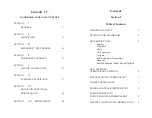
Standard Operating Procedures
L410 UVP-E20
Document No.:
SOP-L410-1
Page 5 - 16
Rev: 1
Date: JAN 18
Prepared by: LA
Checked by: CLS
5.11 Departure Procedure
5.11.1 GPS Nav Setup
The required flight plan must be loaded into the GTN750/650.
Tracks, waypoints and altitude restrictions shall be checked against OFP and published
procedures.
WARNING
If using GPS as the solesource of navigation and operating in IMC:
•
Waypoints
MUST
be checked against published lat/long,bearing and distance
information.
•
A RAIM check must be completed.
•
Crew shall verify that the sensitivity is set to 0.3.
5.11.2 Radio Nav setup
The appropriate radio frequencies required for departure shall be tuned, confirmed and identified
(if possible) by the crew.
5.12 Receiving an ATC Departure or Arrival Clearance
Generally a brief will be carried out prior to receiving an ATC clearance asclearances are
generally not given until taxiing for departure or whenapproaching the airport for arrival.
This is to allow for a more thorough brief ina low workload environment. Due to possible changes
it is important thatboth pilots check ATC Route clearance against GPS route, Altitude Selector,FD
mode, heading bug and transponder code when a clearance is receivedto avoid mistakes.
Refer to briefing example #1
After your brief you receive the following clearance:
ATC: “PK-VSP cleared direct to Nusawiru via BND, after departure maintain runwayheading,stop
altitude 4000 ft, squawk 4273.“
After the PM reads back the clearance the PF will then display the flight planpage and crosscheck
the clearance against the programmed route:
PF: “Cleared direct to Nusawiru via BND
Selects HDG mode and bugs the runway heading “Heading selected and runway heading is
bugged“
PF then checks the Altitude Selector: “4000 ft set“Checks the squawk code: “squawking 4273“
PM: “Check“
Summary of Contents for L410 UVP-E20
Page 5: ......
















































